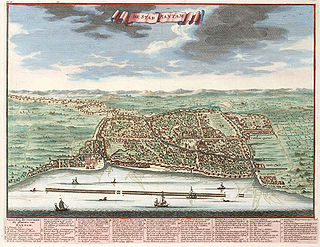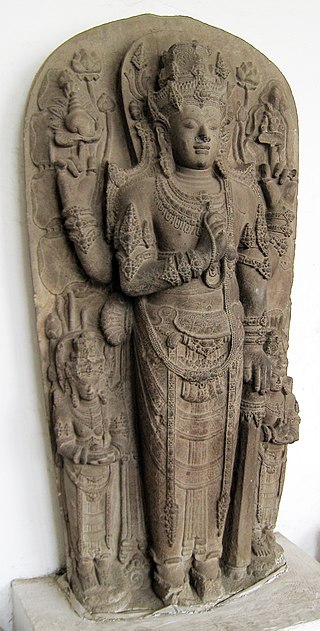Related Research Articles

Banten is the westernmost province on the island of Java, Indonesia. Its capital city is Serang and its largest city is Tangerang. The province borders West Java and the Special Capital Region of Jakarta on the east, the Java Sea on the north, the Indian Ocean on the south, and the Sunda Strait on the west and shares a maritime border with Bengkulu and Lampung to the east and Bangka Belitung Islands to the north. The province covers an area of 9,352.77 km2 (3,611.12 sq mi). It had a population of over 11.9 million in the 2020 census, up from about 10.6 million in 2010. The estimated mid-2023 population was 12.308 million. Formerly part of the province of West Java, Banten was split off to become a province on 17 October 2000.

Srivijaya, also spelled Sri Vijaya, was a Buddhist thalassocratic empire based on the island of Sumatra that influenced much of Southeast Asia. Srivijaya was an important centre for the expansion of Buddhism from the 7th to 11th century AD. Srivijaya was the first polity to dominate much of western Maritime Southeast Asia. Due to its location, Srivijaya developed complex technology utilizing maritime resources. In addition, its economy became progressively reliant on the booming trade in the region, thus transforming it into a prestige goods-based economy.

Banten, also written as Bantam, is a port town near the western end of Java, Indonesia. It has a secure harbour at the mouth of Banten River, a navigable passage for light craft into the island's interior. The town is close to the Sunda Strait through which important ocean-going traffic passes between Java and Sumatra. Formerly Old Banten was the capital of a sultanate in the area, was strategically important and a major centre for trade.

Sukuh is a 15th-century Javanese-Hindu temple (candi) that is located in Berjo, Ngargoyoso district, Karanganyar Regency, Central Java, Indonesia on the western slope of Mount Lawu . This temple has a height of 87 meters. Sukuh temple has a distinctive thematic relief from other candi where life before birth and sexual education are its main themes. Its main monument is a simple pyramid structure with reliefs and statues in front of it, including three tortoises with flattened shells and a male figure grasping his penis. A giant 1.82 m (6 ft) high of Shishna with four testes, representing penile incisions, was one of the statues that has been relocated to the National Museum of Indonesia.

Kingdoms of Sunda refers to the monarchies of the Sundanese region prior to the establishment of Indonesia in 1945 AD. The history includes several eras:
- Salakanagara
- Tarumanagara
- The Sunda Kingdom and Galuh Kingdom
- Kingdom of Sumedang Larang, The Sultanate of Banten & The Sultanate of Cirebon

Tarumanagara or Taruma Kingdom or just Taruma was an early Sundanese Indianised kingdom, located in western Java, whose 5th-century ruler, Purnawarman, produced the earliest known inscriptions in Java, which are estimated to date from around 450 CE.

The Sunda Kingdom was a Sundanese Hindu kingdom located in the western portion of the island of Java from 669 to around 1579, covering the area of present-day Banten, Jakarta, West Java, and the western part of Central Java. The capital of the Sunda Kingdom moved several times during its history, shifting between the Galuh (Kawali) area in the east and Pakuan Pajajaran in the west.

Pakuan Pajajaran was the fortified capital city of Sunda Kingdom. The location roughly corresponds to modern Bogor city in West Java, Indonesia, approximately around the site of Batu Tulis. The site is revered as the spiritual home of Sundanese people as it contains much of the shared identity and history of Sundanese people.

The Galuh Kingdom was a medieval Sundanese kingdom located in the eastern part of Tatar Sunda, present-day Indonesia. It was established as a breakaway kingdom of the Tarumanagara around the 7th century. Traditionally the kingdom was associated with the Central & Eastern Parahyangan cultural regions, with territory spanning from Citarum River in the west, to Cipamali and Cisarayu River in the east. Its capital was first located in Karangkamulyan, Ciamis Regency, then Saunggalah, Kuningan and Kawali, north of present-day Ciamis. The etymology of "galuh" is Old Sundanese and Kawi word for "gemstone".

Port of Tanjung Priok is the busiest and most advanced seaport in Indonesia, handling more than 50% of Indonesia's trans-shipment cargo traffic. The port is located at Tanjung Priok, North Jakarta, which is operated by Indonesian state owned PT Pelindo. The port has 20 terminals for accommodating general cargo, liquid bulk, dry bulk, containers, etc. It has specialised facilities cater to oil tankers, chemical-laden ships, metal scrap and passengers.

The Tugu inscription is one of the early 5th century Tarumanagara inscriptions discovered in Batutumbuh hamlet, Tugu village, Koja, North Jakarta, in Indonesia. The inscription contains information about hydraulic projects; the irrigation and water drainage project of the Chandrabhaga river by the order of Rajadirajaguru, and also the water project of the Gomati river by the order of King Purnawarman in the 22nd year of his reign. The digging project to straighten and widen the river was conducted in order to avoid flooding in the wet season, and as an irrigation project during the dry season.

Kalingga or She-po or She-bo in Chinese sources, or Ho-ling in Arabic scriptures of Umayyad Caliphate era; was a 6th-century Indianized kingdom on the north coast of Central Java, Indonesia.

Devaraja was a religious order of the "god-king," or deified monarch in medieval Southeast Asia. The devarāja order grew out of both Hinduism and separate local traditions depending on the area. It taught that the king was a divine universal ruler, a manifestation of Bhagavan. The concept viewed the monarch to possess transcendental quality, the king as the living god on earth. The concept is closely related to the Indian concept of Chakravarti. In politics, it is viewed as the divine justification of a king's rule. The concept was institutionalized and gained its elaborate manifestations in ancient Java and Cambodia, where monuments such as Prambanan and Angkor Wat were erected to celebrate the king's divine rule on earth.
A good number of inscriptions written in Sanskrit language have been found in Malaysia and Indonesia. "Early inscriptions written in Indian languages and scripts abound in Southeast Asia. [...] The fact that southern Indian languages didn't travel eastwards along with the script further suggests that the main carriers of ideas from the southeast coast of India to the east - and the main users in Southeast Asia of religious texts written in Sanskrit and Pali - were Southeast Asians themselves. The spread of these north Indian sacred languages thus provides no specific evidence for any movements of South Asian individuals or groups to Southeast Asia.

Purnawarman or Purnavarman was the 5th-century king of Tarumanagara, a Hindu Indianized kingdom, located in modern-day West Java, Jakarta and Banten provinces, Indonesia. Purnawarman reigned during the 5th century, and during his reign he created several stone inscriptions.

Ciaruteun inscription also written Ciarutön or also known as Ciampea inscription is a 5th-century stone inscription discovered on the riverbed of Ciaruteun River, a tributary of Cisadane River, not far from Bogor, West Java, Indonesia. The inscription is dated from the Tarumanagara kingdom period, one of the earliest Hindu kingdoms in Indonesian history. The inscription states King Purnawarman is the ruler of Tarumanagara.

Kebonkopi II inscription or Pasir Muara inscription or Rakryan Juru Pangambat inscription is the oldest inscription that mentioned the toponymy Sunda dated from 854 Saka, discovered in Kebon Kopi village, Bogor, near Kebon Kopi I inscription, and named as such to differ it from this older inscription dated from Tarumanagara era.

Kebon Kopi I also known as Tapak Gajah inscription, is one of several inscriptions dated from the era of Tarumanagara Kingdom circa 5th century. The inscription bearing the image of elephant footprint, which was copied from the elephant ride of King Purnawarman of Tarumanagara, which is equated with Airavata, the elephant vahana (vehicle) of Indra.

The history of Sunda Kingdom spanned almost a millennium, between 7th to 16th century. It is not sure however, whether the Sunda Kingdom was actually a continuous polity or not, nor whether its rulers belongs to a single continuous lineage of dynasty or not. This is because the scarcity of evidences, historical records and archaeological findings that plausibly connected to this kingdom.

Kali Bekasi is a river that originates from a confluence of the Cikeas and Cileungsi rivers in the south of the border between the city of Bekasi and Bogor Regency. It flows northward, cutting through the city center of Bekasi towards the downstream area in Bekasi Regency, where it merges the flood control canal CBL (Cikarang-Bekasi-Laut), built during the era of President Soeharto's government in 1977 to prevent flooding in the northern coastal region of Bekasi. This canal intercepts numerous tributaries coming from the south, spanning from Cikarang to Bekasi. From the confluence point in the Babelan district, its flow is directed northwest until it meets the eastern of Jakarta Bay, part of the Java Sea.
References
- 1 2 3 4 5 6 Santiko, Hariani (December 2013). "The Vedic Religion In Nusantara". AMERTA, Jurnal Penelitian Dan Pengembangan Arkeologi. 31 (2): 81–150.
- ↑ Iguchi, Masatoshi (2015). Java Essay: The History and Culture of a Southern Country. Troubador Publishing Ltd. ISBN 9781784621513.
- 1 2 Klokke, Marijke J.; van Kooij, K. R. (2001). Fruits of Inspiration: Studies in Honour of Prof. J.G. de Casparis. Egbert Forsten. ISBN 9789069801377.
- 1 2 Zahorka, Herwig (2007). The Sunda Kingdoms of West Java: From Tarumanagara to Pakuan Pajajaran with the Royal Center of Bogor : Over 1000 Years of Prosperity and Glory. Yayasan Cipta Loka Caraka.